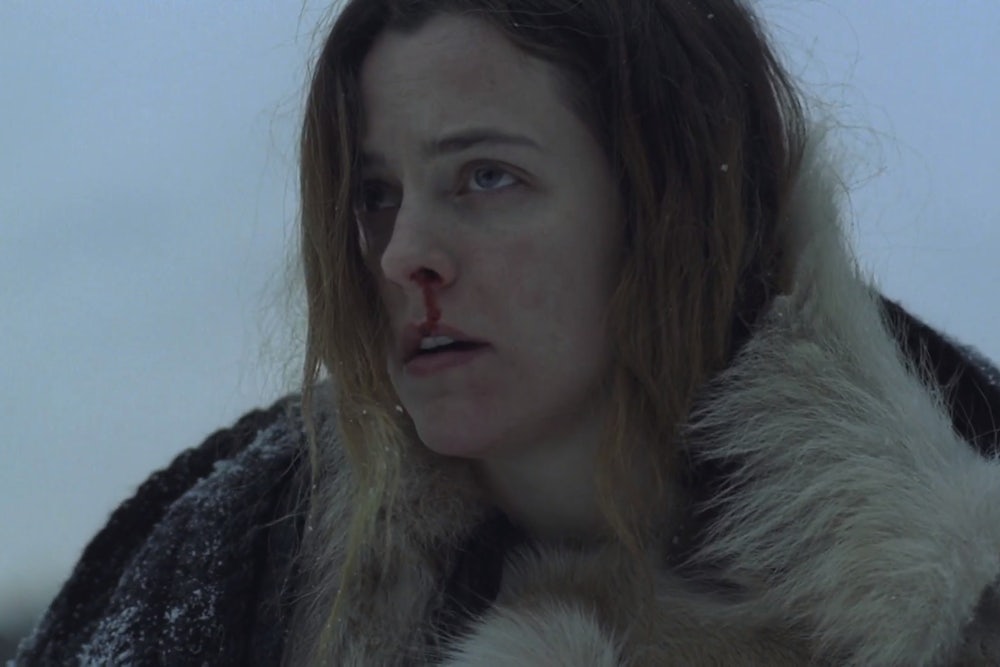Horror destabilizes, but it follows rules. It is illicit and thrilling but temporary: like taking drugs, only safe. So I tell myself, anyway, when I have to watch a horror movie. Just in case, I saw The Lodge first thing in the morning, comforted knowing there was a sunny day waiting for me outside.
The directors, Veronika Franz and Severin Fiala, last collaborated on 2014’s Goodnight Mommy, a meditative film featuring creepy twin brothers at play in a bucolic world where nothing is quite as it seems. That’s the other convention of horror that I find it comforting to hold close—the film aims to abuse you, so there’s no chance of being seduced into trust.
The Lodge opens with shots of an interior, and if you’re paying attention you realize the rooms look uncanny because they’re in a dollhouse. We then see the real home that contains this dollhouse, and a mother and her kids preparing for their day. She (Alicia Silverstone) drives her son, Aidan (Jaeden Martell), and daughter, Mia (Lia McHugh), to stay the weekend with their father, her estranged husband (Richard Armitage).
Only a few minutes in, there’s a turn so surprising that I can’t, in good conscience, spoil it. So I’ll note instead how the film dwells on rooms, the contrast between the sunny traditional home of the mother, Laura, and the coolly modernist place belonging to the father, Richard. That dollhouse looms; it seems to stage the horrors that will unfold in the film we are watching, though whether Mia, to whom the dollhouse belongs, is the author of those vignettes is harder to answer. It seems obvious that a movie called The Lodge would have an interest in spaces—but what do all these beautifully framed interiors add up to?
Then there’s the eponymous lodge, where Richard and his new love interest, Grace (Riley Keough), take the kids for a Christmas holiday. We learn that Richard met Grace when he was writing a book and that she’s the sole survivor of a Christian sect that committed mass suicide. It turns out this is the story of the world’s worst father, because her mental instability is evident but still Richard heads back to civilization for work, leaving her and his two children alone in splendid isolation that would look, in any non–horror film, beautiful. Can you guess what happens next?
The Lodge is haunted by its predecessors: a dash of The Shining, a twist of The Exorcist. Part of the perverse pleasure of the genre is recognizing familiar strategies. Can we take any of what we see—Grace sleepwalking into the snow, the disappearance of a pet dog, Mia playing with her favorite doll—on faith? We know that we cannot. Indeed faith itself becomes the movie’s subject. We and the kids have seen the video evidence: younger Grace, wandering about a basement filled with the corpses of true believers, their mouths sealed with duct tape upon which someone has scrawled the word “sin.”
So many horror films depict religious feeling as mania, madness, danger: something of which to be frightened. In these movies, people who believe are so often in communion with evil. Doesn’t this indict the audience accepting on faith the feints and assertions of the film itself? I can’t make sense of this beyond to lament it. Grace could just as well have been the sole survivor of a cult that believed in aliens or a gang of libertarians who chose death over taxes. We’re habituated to God as an essential ingredient in a well-crafted scare. The absolute worst moment in The Lodge is its heavy-handed (also: far too loud) use of an organ in the soundtrack. I get it! I don’t know if there’s a killer in the house, but I know God is in there.
Keough is initially an engaging presence, but Grace’s gradual, inevitable descent into madness is not that interesting to watch: neither broad and campy nor precise and heartbreaking. As an unpleasant teen, Martell is a pleasant foil to her; the children are our proxies, and they’re fun to watch and believably childlike, which is so unusual that this ends up being one of the movie’s biggest surprises. But there is another of those, a revelation I am honor-bound not to ruin, that does recalibrate how the film works on you.
The movie is frightening. I started more than once, fidgeted nervously when things grew too foreboding or I sensed I could not trust the screen with my attention. But I am not sure The Lodge is more than a system of scares, barely holding together: I don’t think the movie satisfies. This is the ambition of the independent horror movie—to deliver fright that coalesces into meaning. But the gestures toward meaning feel not shallow but incomplete: Here’s a dollhouse, here’s a room; see what we mean? I don’t, but maybe it’s because I have my hands over my eyes, too afraid too look.
